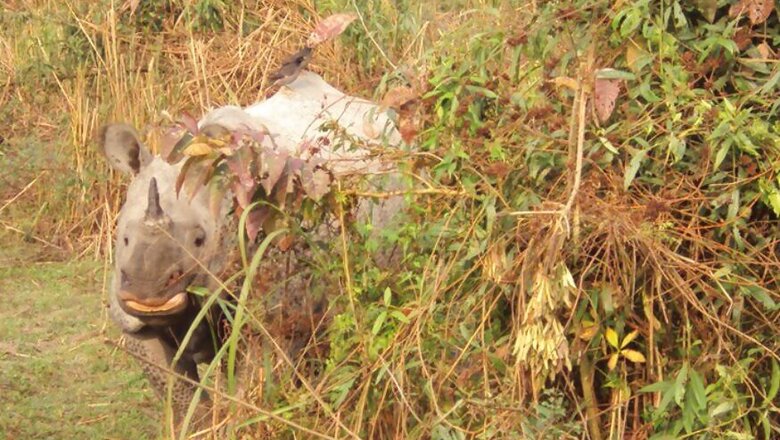
views
Guwahati: Assam has seen a steady rise in the number of one-horned rhinos in Kaziranga national park with the total number standing at an impressive 2,413, which is an increase of 12 more from the last rhino census conducted in 2015.
The number stood at 366 in the late sixties, which is a far cry from the present number.
Kaziranga is home to about 70 percent of the one-horned rhino population in the world.
Enumerators involved in the rhino census suggest a repeat of the census next year after proper evaluation of the field conditions essential for counting. The rhino count was conducted in Kaziranga over two days on March 26-27.
The best of experts in wildlife research and census-taking got together after three years for the exercise.
Park authorities used more than 40 elephants and 17 SUVs to work out the total number of rhinos in the park.
A total area of 882 sqkm, including the Brahmaputra river zone which makes for the 6th Addition to Kaziranga, was divided into 74 compartments for the census count, of which 36 blocks were covered the first day.
Enumerators, who did the actual physical counting, were not completely satisfied with the sightings this time as tall and thick grasslands with high-moisture content affected visibility.
Kaushik Barua, wildlife conservationist from Assam who was also part of the census count, told News18 that grassland burning this season was not upto the desired level.
“Due to untimely rains, the park authorities couldn't burn the grass in most areas. Almost 70 percent of the grassland remained intact. This obstructed line of sight for the enumerators and made it difficult for them to locate rhinos. We experienced it mainly in Agoratoli Range,” said Barua.
Besides low visibility, the exact number of rhinos could not be worked out because of several other reasons.
“In many areas heavy machinery was being engaged to construct highlands. This had disturbed the usual distribution of rhinos in that area. On the second day, the sun came out around 10.30-11.00 am. It was a while before the rhinos came out of cover to wallow. Enumerators who had visited water bodies in search of rhinos before the sun had come out are bound to have seen low numbers or no rhinos at all,” remarked Barua.
The results and feedback by enumerators is fed to the technical committee constituted under the Principal Chief Conservator of Forests (PCCF), and all factors are examined once the compilation is over.
NK Vasu, the state principal chief conservator of forests (wildlife) told News 18 that on technical committee recommendation, the census-count will be repeated next year as all compartments could not be covered this time.
“A good number of private elephants and their mahouts whose services were requisitioned for the census were not well acquainted with the dense grasslands in which they were operating. This made it difficult for the enumerators to cover the entire area of certain compartments,” observed Kaushik Barua.
The rhino population in Assam saw a boom of 2,048 rhinos in 2009, an unimaginable increase of 193 rhinos in three years’ time. From 1,855 rhinos in 2006, the population had been briskly swelling up.
An exponential rise in rhino poaching was observed between 2001 and 2016, with poachers killing 239 rhinos. Three rhinos were killed by poachers in Kaziranga in the first three months of this year, while six were poached last year. A total of 342 rhinos have died between March 2015 and March 2018. Considering this, the current population figure in Kaziranga seems to hold good. There are 793 breeding females of the 2,413 rhinos in Kaziranga counted this year.
In 1905, Laokhowa in the south bank of Brahmaputra, Manas, and Kaziranga were declared as the rhino bearing areas in Assam. Over a period of more than 100 years, the population of rhinos in Kaziranga has grown phenomenally. Experts, however, are of the opinion that the park is way beyond the carrying capacity for rhinos.
An IUCN population module had recently stated that the rhino population in Kaziranga had reached its saturation, which would slow down the growth rate unless new areas are added or at least 50 rhinos are harvested every year.
“A number of river islands with a lot of good grass have already been added to the park area. A large number of cattle had moved out of those areas leaving the place suitable for rhinos,” said NK Vasu.
The Indian Rhino Vision 2020, an ambitious plan launched in 2005 to attain a wild population of at least 3,000 greater one-horned rhinos in Assam by the year 2020, has yielded good results.
International Rhino Foundation (IRF) has partnered with the Assam Forest Department, the Bodoland Territorial Council, the World Wide Fund for Nature (WWF), and the US Fish and Wildlife Service to address the threats facing Indian rhinos.
The rhino translocation began in April 2008. So far, rhinos have been moved from Kaziranga National Park and Pabitora Wildlife Sanctuary to other protected areas where they can breed.



















Comments
0 comment